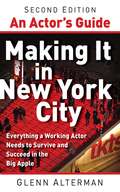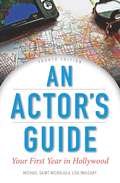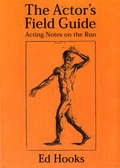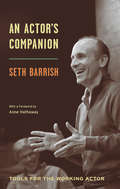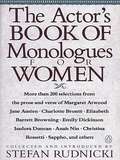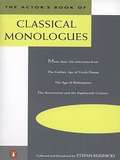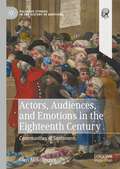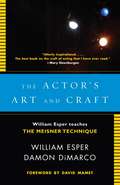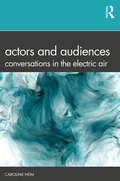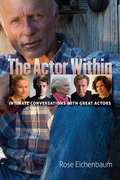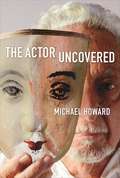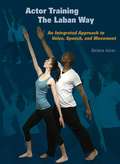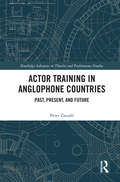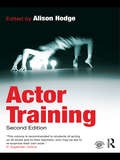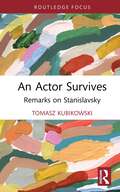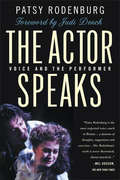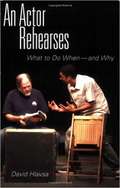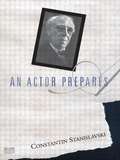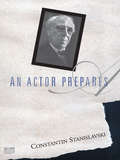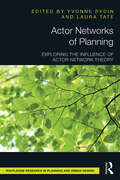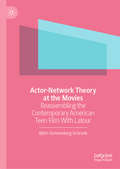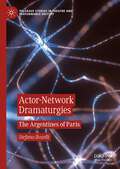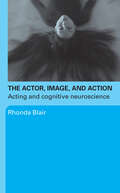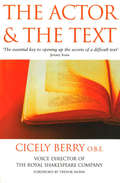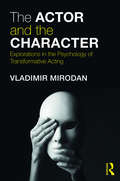- Table View
- List View
An Actor's Guide--Making It in New York City: Everything a Working Actor Needs to Survive and Succeed in the Big Apple
by Glenn AltermanFor any actor in or on the way to New York City, this is the definitive source for advice, winning strategies, marketing techniques, and invaluable insights to being a successful New York actor. This new edition has been completely revised and updated to cover the significant changes in the New York theater landscape over the last nine years. This indispensable guide has also been expanded to include dozens of new interviews with top New York City actors and a completely improved Internet chapter equipped with the most up-to-date tools to thrive in the industry. Aspiring and established professionals will find this thorough and up-to-the-minute volume chock full of resources and advice about auditioning, making professional connections, promoting one's self, seeking opportunities in nontraditional venues, finding an apartment, securing "survival jobs," understanding actor unions, getting headshots, and furthering one's actor training in New York. This guide also details working as a film extra, careers in print modeling, scams and rip-offs to avoid, opportunities for actors with disabilities, and using the Internet to the fullest advantage. Included are in-depth interviews with legendary show business figures such as actor Henry Winkler, casting director Juliet Taylor, and theater director Joseph Chaikin as well as top talents from the fields of film, television, stage, commercials, and talent agencies. Written by a professional New York actor with over thirty years of experience, this meticulously researched guide will give actors the tools they need to survive and thrive in New York show business.
Actor's Guide: Your First Year in Hollywood
by Lisa Mulcahy Michael St. NicolasFor every actor beginning a career in Hollywood, this indispensable guide will lay out a clear and comprehensible path with tried-and-true advice. Up-to-date resources and new interviews with recently established actors experiencing the current movieland scene--as well as the timeless voices of established actors and industry pros--make this a rich compendium of Hollywood know-how. Delve into the industry with the support from An Actor’s Guide: Your First Year in Hollywood and discover with confidence how to: Find work through a variety of sources Deliver stunning auditions Join SAG-AFTRA Get a great headshot and put together a stunning resume Build your credentials and gain exposure Hone your craft with professional training and classes Snag a top-notch agent Utilize the power of social media From settling into Los Angeles and sticking to a tight budget, to adventures in reality TV and landing the breakthrough parts you came to Hollywood for, any actor eager to learn will get his or her fair share of insider knowledge with this manual and will discover how to create a positive experience while launching an exciting career.
The Actor's Field Guide
by Ed HooksFrom a veteran actor, teacher, and author, here is a quick-reference guide aimed at working actors. Got a funny scene that doesn't seem very funny? Look up "comedy." Got a scene in which you're supposed to cry? Look up "cry." Each entry includes a brief introduction to the topic, followed by several pages of short, bulleted tips or "field notes" that offer quick solutions to any acting problem. In addition, there are brief essays throughout that expand on some of the trickier aspects of the actor's craft. Edgy, concise, and infinitely helpful, no working actor will want to be without this one-of-a-kind guide.* There are 100,000 members in actors unions in the US, with a 50% turnover* Unique quick reference guide for busy actors* Advice on everything from rehersals to auditioning and memorizing lines* Author has trained thousands of actors, including Heather Locklear and Teri Hatcher* Advertising in Back Stage magazineFrom the Trade Paperback edition.
An Actor's Companion
by Seth Barrish Anne Hathaway"I was totally unprepared for the transformation that Seth's technique created in me. . . . I realized that what I thought I knew about acting up to that point was largely misguided . . . but I now had a great, talented, dedicated teacher who generously wanted to share his tools with everyone. There is muscularity, not to mention wisdom and truth to Seth's techniques. He is a wonderful teacher, and I know that having him as my first guide is one of the luckiest things to have happened to me in my career and life. And when I can't get back to class with him, I am so grateful I have this book to turn to."--Anne Hathaway"This book is truly unlike anything else I know--these pieces are haikus on specific elements of performance and character building."--Philip Himberg, executive director, Sundance Theatre InstituteA collection of practical acting tips, tools, and exercises, An Actor's Companion is ideal for both the seasoned professionals and actors-in-training. The tips--all simple, direct, and useful--are easy to understand and even easier to apply, in both rehearsal and in performance.Seth Barrish is an actor, teacher, and the co-artistic director of The Barrow Group in New York City. In his thirty-year career, he has directed the award-winning shows My Girlfriend's Boyfriend (Lucille Lortel Award for Best Solo Show, Drama Desk and Outer Critics Circle nominations for Best Solo Show), Sleepwalk With Me (Nightlife Award for Outstanding Comedian in a Major Performance), The Tricky Part (Obie Award, Drama Desk nominations for Best Play and Best Solo Show), Pentecost (Drama Desk nomination for Best Play), Old Wicked Songs (Los Angeles Drama Critics Circle Award and Garland Award for Best Direction), and Good (Straw Hat Award for Best Direction), among dozens of others.
The Actor's Book of Monologues for Women
by VariousA diverse collection of monologues featuring the voices of women through the ages Drawn from poetry, fiction, diaries, journals, and documents of public record, these selections, although not originally intended for theatrical or cinematic performances, offer unique dramatic opportunities for actors, speakers, students, or anyone interested in women’s studies. Stefan Rudnicki has brought together selections from well-known as well as obscure authors, providing a tremendous range of women’s perspectives from a variety of sources: poems by Elizabeth Barrett Browning, Emily Dickinson, Christina Rossetti, and Sappho, among others; passages from Mary Shelley’s journal, the diaries of Anais Nin, and the memoirs of Isadora Duncan; polemics from Mary Wollstonecraft and Joan of Arc, as well as Susan B. Anthony’s “On Woman’s Right to Suffrage”; and selections from the novels of Emily and Charlotte Bronte, Jane Austen, Ursula K. LeGuin, and others.
The Actor's Book of Classical Monologues
by VariousA challenging, wide-ranging collection of monologues from history’s greatest dramatic works. From the stately and poetic Greek tragedies to the lively, bawdy Restoration comedies, the classical repertoire is a treasure trove of often-overlooked materials for male and female, young and old. The solo pieces collected here vary widely in mood, style, and level of challenge; they include a generous supply of Shakespeare and his contemporaries; and they’re fleshed out with brief plot synopses and valuable historical material. Stefan Rudnicki, an accomplished actor, director, and teacher, also provides practical tips on preparing each scene for audition or performance. Among the playwrights whose works are included are: Aeschylus Sophocles Euridipes Aristophanes Shakespeare Tourneur Kyd Middleton Jonson Sheridan Dryden Congreve …and many others.
Actors, Audiences, and Emotions in the Eighteenth Century: Communities of Sentiment (Palgrave Studies in the History of Emotions)
by Glen McGillivrayThis book offers an innovative account of how audiences and actors emotionally interacted in the English theatre during the middle decades of the eighteenth century, a period bookended by two of its stars: David Garrick and Sarah Siddons. Drawing upon recent scholarship on the history of emotions, it uses practice theory to challenge the view that emotional interactions between actors and audiences were governed by empathy. It carefully works through how actors communicated emotions through their voices, faces and gestures, how audiences appraised these performances, and mobilised and regulated their own emotional responses. Crucially, this book reveals how theatre spaces mediated the emotional practices of audiences and actors alike. It examines how their public and frequently political interactions were enabled by these spaces.
The Actor's Art and Craft: William Esper Teaches the Meisner Technique
by William Esper Damon DimarcoWilliam Esper, one of the leading acting teachers of our time, explains and extends Sanford Meisner's legendary technique, offering a clear, concrete, step-by-step approach to becoming a truly creative actor.Esper worked closely with Meisner for seventeen years and has spent decades developing his famous program for actor's training. The result is a rigorous system of exercises that builds a solid foundation of acting skills from the ground up, and that is flexible enough to be applied to any challenge an actor faces, from soap operas to Shakespeare. Co-writer Damon DiMarco, a former student of Esper's, spent over a year observing his mentor teaching first-year acting students. In this book he recreates that experience for us, allowing us to see how the progression of exercises works in practice. The Actor's Art and Craft vividly demonstrates that good training does not constrain actors' instincts--it frees them to create characters with truthful and compelling inner lives.From the Trade Paperback edition.
Actors and Audiences: Conversations in the Electric Air
by Caroline HeimActors and Audiences explores the exchanges between those on and off the stage that fill the atmosphere with energy and vitality. Caroline Heim utilises the concept of "electric air" to describe this phenomenon and discuss the charge of emotional electricity that heightens the audience’s senses in the theatre. In order to understand this electric air, Heim draws from in-depth interviews with 79 professional audience members and 22 international stage and screen actors in the United Kingdom, United States, France and Germany. Tapping into the growing interest in empirical studies of the audience, this book documents experiences from three productions – The Encounter, Heisenberg and Hunger. Peer Gynt – to describe the nature of these conversations. The interviews disclose essential elements: transference, identification, projection, double consciousness, presence, stage fright and the suspension of disbelief. Ultimately Heim reveals that the heart of theatre is the relationship between those on- and off-stage, the way in which emotions and words create psychological conversations that pass through the fourth wall into an "in-between space," and the resulting electric air. A fascinating introduction to a unique subject, this book provides a close examination of actor and audience perspectives, which is essential reading for students and academics of Theatre, Performance and Audience Studies.
The Actor Within: Intimate Conversations with Great Actors
by Rose Eichenbaum Aron Hirt-ManheimerIn Rose Eichenbaum's third work on the confluence of art making and human expression, she delves into the lives of thirty-five celebrated actors through intimate conversations and photographic portraits. With her probing questions and disarming manner, she captures the essential character of her subjects while shining a light on the art that defines them. The work provides extraordinary insights on the craft of acting with discussions of process, techniques, tools of the trade, and how to advice for aspiring actors from seasoned veterans. These stars of stage and screen, known for signature roles and critically acclaimed performances, emerge in The Actor Within with masks and wardrobe removed. Here, they speak their own lines, tell their own stories, and raise the curtain on what it means to live the actor's life--the challenge of mastering their craft, the drama of big breaks and career woes, the search for meaningful roles, and above all, having the courage to bare their souls before theater audiences or the camera. For the artists featured in this work, acting is more than a profession; it is how they make their way in the world and artfully merge their inner sense of humanness with universal truths. This collection serves as an important inspirational resource for anyone interested in making art, regardless of medium.The Actor Within includes interviews with Karl Malden, Ruby Dee, Ed Harris, Piper Laurie, Marcia Gay Harden, William H. Macy, Ellen Burstyn, Joe Mantegna, Debra Winger, Julia Stiles, Elliott Gould, Elijah Wood, Stockard Channing, Bill Pullman, Amanda Plummer, Marlee Matlin, Charles Durning, Marsha Mason, and many others.
The Actor Uncovered
by Michael HowardA Far-Reaching and Truthful Exploration of Acting in All Its FormsThe Actor Uncovered is certainly not a set of rigid rules advocating one "method" or one singular "truth." Departing from the common guidebook format, Michael Howard uses a unique approach to teaching acting, reflecting on his own history and sharing his own experiences as an actor, director, and teacher. How he writes about the process and craft of acting is at once intensely personal and relatable by others.Readers are invited to participate as though present in this master teacher's classes. Each human being, and thus each actor, is unique. Howard encourages actors to uncover their own ways of working, using their particular abilities and personality traits. Going beyond the craft and into human psychology and the importance of acting as a life force, readers will see new and deeper ways to study and practice, to be introspective, and to arrive at places of revelation about their craft.The Actor Uncovered will have much to say to beginners, to those who are advanced, and to professional and working actors. Howard discusses such topics as:Techniques, styles, and methods in a changing societyRelaxation, concentration, and the breathThe relationships among actor, director, and writerMemoryOn camera versus on stageObstaclesAfter more than seventy years as a professional actor, director, and teacher, Howard shows how living creatively and invoking one's own personality can lead to a successful career as an actor.
Actor Training the Laban Way: An Integrated Approach to Voice, Speech, and Movement
by Barbara Adrian* Individual, partner, and group exercises to make any actor more expressive * Crucial acting tips based on the work of distinguished theorist Rudolf Laban * 65 original illustrations of anatomy and warm-up exercises This in-depth, fully illustrated guide offers a groundbreaking approach to understanding physical and vocal movement that will enable readers to discover how to maximize their potential. Packed with practical exercises for individuals, partners, and group work, this book integrates voice, speech, and movement. Exercises for breath support, tone, range, articulation, dynamic alignment, balance, flexibility, strength, and stamina, as well as building relationships, Actor Training the Laban Way is essential reading for all serious actors, acting teachers, and students.
Actor Training in Anglophone Countries: Past, Present and Future (Routledge Advances in Theatre & Performance Studies)
by Peter ZazzaliActor Training in Anglophone Countries offers a firsthand account of the most significant acting programs in English-speaking countries throughout the world. The culmination of archival research and fieldwork spanning six years, it is the only work of its kind that studies the history of actor training from an international perspective. It presents the current moment as crucial for student actors and those who teach them. As the profession continues to change, new and progressive approaches to training have become as urgent as they are necessary. Using drama schools and universities as its subjects of inquiry, this book investigates acting programs in the UK, Ireland, the US, Canada, Australia, and New Zealand. Among the case studies are the Royal Academy of Dramatic Art, National Theatre School of Canada, Western Australian Academy of Performing Arts, and Carnegie Mellon University. All recognized for their distinguished reputations by industry professionals and acting teachers alike, the book examines each program’s pedagogical approach, administrative structure, funding apparatus, and alumni success. In doing so, it identifies the challenges facing acting schools today and offers a new direction for training in the twenty-first century. Actor Training in Anglophone Countries will be of interest to theatre and performance scholars, artists, students, and teachers.
Actor Training
by Alison HodgeActor Training expands on Alison Hodge's highly-acclaimed and best-selling Twentieth Century Actor Training. This exciting second edition radically updates the original book making it even more valuable for any student of the history and practice of actor training. The bibliography is brought right up to date and many chapters are revised. In addition, eight more practitioners are included - and forty more photographs - to create a stunningly comprehensive study. The practitioners included are: Stella Adler; Eugenio Barba; Augusto Boal; Anne Bogart; Bertolt Brecht; Peter Brook; Michael Chekhov; Joseph Chaikin; Jacques Copeau; Philippe Gaulier; Jerzy Grotowski; Maria Knebel; Jacques Lecoq; Joan Littlewood; Sanford Meisner; Vsevolod Meyerhold; Ariane Mnouchkine; Monika Pagneux; Michel Saint-Denis; Włodzimierz Staniewski; Konstantin Stanislavsky; Lee Strasberg The historical, cultural and political context of each practitioner's work is clearly set out by leading experts and accompanied by an incisive and enlightening analysis of the main principles of their training, practical exercises and key productions. This book is an invaluable introduction to the principles and practice of actor training and its role in shaping modern theatre.
An Actor Survives: Remarks on Stanislavsky (Routledge Advances in Theatre & Performance Studies)
by Tomasz KubikowskiThis book focuses on the analysis and interpretation of the first volume of the book An Actor’s Work by Konstantin Stanislavsky. This volume is the only part of his planned major work on theatre art that he was able to finish and authorise before his death. Its highly edited variant has long been known as ‘An Actor Prepares’ in the English-speaking world. Tomasz Kubikowski explores Stanislavsky’s material not only as a handbook of acting but also as a philosophical testament of Stanislavsky, in which he attempts to contain his most essential experiences and reflections. This book explores the underlying theme of ‘survival’ in its various meanings, from professional to existential; and the mechanisms and actions we attempt to survive. This study will be of great interest to students and scholars in theatre and performance studies.
The Actor Speaks
by Patsy RodenburgIn The Actor Speaks, Patsy Rodenburg takes actors and actresses, both professional and beginners, through a complete voice workshop. She touches on every aspect of performance work that involves the voice and sorts through the kinds of vexing problems every performer faces onstage: breath and relaxation; vocal range and power; communication with other actors; singing and acting simultaneously; working on different sized stages and in both large and small auditoriums; approaching the vocal demands of different kinds of scripts. This is the final word on the actor's voice and it's destined to become the classic work on the subject for some time to come.
An Actor Rehearses: What to Do When and Why
by David HlavsaWith a commonsense approach, An Actor Rehearses takes performers through the rehearsal process and explains exactly what to do when. The actor’s process is explained simply, sequentially, and in detail, starting from the period before rehearsals begin and continuing through first read-through, blocking rehearsals, technical rehearsals, and performances. Packed with exercises that are useful in the classroom and in the rehearsal studio, An Actor Rehearses is an indispensable guide to the rehearsal process that makes building a character easier and more rewarding for both actor and audience. And because author David Hlavsa’s emphasis is on relating acting to life, performers learn to make a remarkable connection between becoming a better actor and becoming a better person: more compassionate, more vital, more alive. Clear, practical, usable advice for actors at every level Unique focus: learning to become a better actor means learning to become a better person Huge potential audienceAllworth Press, an imprint of Skyhorse Publishing, publishes a broad range of books on the visual and performing arts, with emphasis on the business of art. Our titles cover subjects such as graphic design, theater, branding, fine art, photography, interior design, writing, acting, film, how to start careers, business and legal forms, business practices, and more. While we don't aspire to publish a New York Times bestseller or a national bestseller, we are deeply committed to quality books that help creative professionals succeed and thrive. We often publish in areas overlooked by other publishers and welcome the author whose expertise can help our audience of readers.
An Actor Prepares
by Constantin StanislavskiThe first volume of Stanislavski's enduring trilogy on the art of acting defines the "System", a means of mastering the craft of acting and of stimulating the actor's individual creativeness and imagination.
An Actor Prepares (Bloomsbury Revelations Ser.)
by Constantin StanislavskiStanislavski's simple exercises fire the imagination, and help readers not only discover their own conception of reality but how to reproduce it as well.
Actor Networks of Planning: Exploring the Influence of Actor Network Theory
by Yvonne Rydin Laura TatePlanning is centrally focused on places which are significant to people, including both the built and natural environments. In making changes to these places, planning outcomes inevitably benefit some and disadvantage others. It is perhaps surprising that Actor Network Theory (ANT) has only recently been considered as an appropriate lens through which to understand planning practice. This book brings together an international range of contributors to explore such potential of ANT in more detail. While it can be thought of as a subset of complexity theory, given its appreciation for non-linear processes and responses, ANT has its roots in the sociology of scientific and technology studies. ANT now comprises a rich set of concepts that can be applied in research, theoretical and empirical. It is a relational approach that posits a radical symmetry between social and material actors (or actants). It suggests the importance of dynamic processes by which networks of relationships become formed, shift and have effect. And while not inherently normative, ANT has the potential to strengthen other more normative domains of planning theory through its unique analytical lens. However, this requires theoretical and empirical work and the papers in this volume undertake such work. This is the first volume to provide a full consideration of how ANT can contribute to planning studies, and suggests a research agenda for conceptual development and empirical application of the theory.
Actor-Network Theory at the Movies: Reassembling the Contemporary American Teen Film With Latour
by Björn Sonnenberg-SchrankThis book is one of the first to apply the theoretical tools proposed by French philosopher Bruno Latour to film studies. Through the example of the Hollywood Teen Film and with a particular focus on Actor-Network Theory (ANT), the book delineates how Teen Film has established itself as one of Hollywood’s most consistent and dynamic genres. While many productions may recycle formulaic patterns, there is also a proliferation of cinematic coming-of-age narratives that are aesthetically and politically progressive, experimental, and complex. The case studies develop a Latourian film semiotics as a flexible analytical approach which raises new questions, not only about the history, types and tropes of teen films, but also about their aesthetics, mediality, and composition. Through an exploration of a wide and diverse range of examples from the past decade, including films by female and African-American directors, urban and rural perspectives, and non-heteronormative sexualities, Actor-Network Theory at the Movies demonstrates how the classic Teen Film canon has been regurgitated, expanded, and renewed.
Actor-Network Dramaturgies: The Argentines of Paris (Palgrave Studies in Theatre and Performance History)
by Stefano BoselliThis book provides key critical tools to significantly broaden the readers’ perception of theatre and performance history: in line with posthuman thought, each chapter engages Actor-Network Theory and similar theories to reveal a comprehensive range of human and non-human agents whose collaborations impact theatre productions but are often overlooked. The volume also greatly expands the information available in English on the networks created by several Argentine artists. Through a transnational, transatlantic perspective, case studies refer to the lives, theatre companies, staged productions, and visual artworks of a number of artists who left Buenos Aires during the 1960s due to a mix of personal and political reasons. By establishing themselves in the French capital, queer playwright Copi and directors Jorge Lavelli, Alfredo Arias, and Jérôme Savary, among others, became part of the larger group of intellectuals known as “the Argentines of Paris” and dominated the Parisian theatre scene between the 1980s and 90s. Focusing on these Argentine artists and their nomadic peripeteias, the study thus offers a detailed description of the complexity of agencies and assemblages inextricably involved in theatre productions, including larger historical events, everyday objects, sexual orientation, microbes, and even those agents at work well before a production is conceived.
The Actor, Image, and Action: Acting and Cognitive Neuroscience
by Rhonda BlairThe Actor, Image and Action is a 'new generation' approach to the craft of acting; the first full-length study of actor training using the insights of cognitive neuroscience. In a brilliant reassessment of both the practice and theory of acting, Rhonda Blair examines the physiological relationship between bodily action and emotional experience. In doing so she provides the latest step in Stanislavsky's attempts to help the actor 'reach the unconscious by conscious means'. Recent developments in scientific thinking about the connections between biology and cognition require new ways of understanding many elements of human activity, including: imagination emotion memory physicality reason. The Actor, Image and Action looks at how these are in fact inseparable in the brain's structure and function, and their crucial importance to an actor’s engagement with a role. The book vastly improves our understanding of the actor's process and is a must for any actor or student of acting.
The Actor And The Text
by Cicely BerryCicely Berry, Voice Director of the Royal Shakespeare Company, is world-famous for her voice teaching. The Actor and the Text is her classic book, distilled from years of working with actors of the highest calibre.
The Actor and the Character: Explorations in the Psychology of Transformative Acting
by Vladimir MirodanTransformative acting remains the aspiration of many an emerging actor, and constitutes the achievement of some of the most acclaimed performances of our age: Daniel Day-Lewis as Lincoln, Meryl Streep as Mrs Thatcher, Anthony Hopkins as Hannibal Lecter – the list is extensive, and we all have our favourites. But what are the physical and psychological processes which enable actors to create characters so different from themselves? To understand this unique phenomenon, Vladimir Mirodan provides both a historical overview of the evolution of notions of 'character' in Western theatre and a stunning contemporary analysis of the theoretical implications of transformative acting. The Actor and the Character: Surveys the main debates surrounding the concept of dramatic character and – contrary to recent trends – explains why transformative actors conceive their characters as ‘independent’ of their own personalities. Describes some important techniques used by actors to construct their characters by physical means: work on objects, neutral and character masks, Laban movement analysis, Viewpoints, etc. Examines the psychology behind transformative acting from the perspectives of both psychoanalysis and scientific psychology and, based on recent developments in psychology, asks whether transformation is not just acting folklore but may actually entail temporary changes to the brain structures of the actors. The Actor and the Character speaks not only to academics and students studying actor training and acting theory, but contributes to current lively academic debates around character. This is a compelling and original exploration of the limits of acting theory and practice, psychology, and creative work, in which Mirodan boldly re-examines some of the fundamental assumptions of actor training and some basic tenets of theatre practice to ask: What happens when one of us ‘becomes somebody else’?
